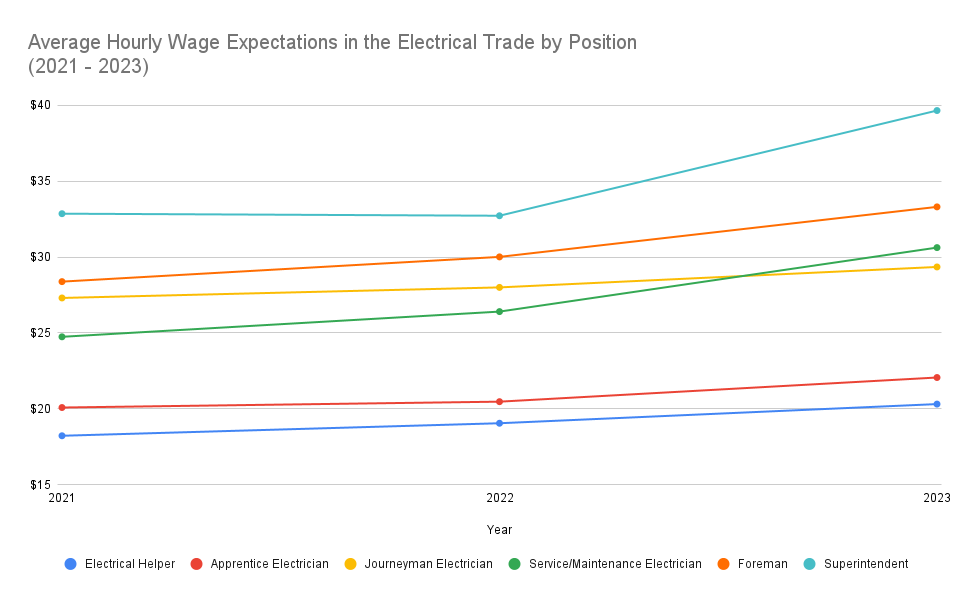As the baby boomer generation continues to retire, electrical superintendents and foremen are aging out at a pace that the industry hasn’t kept up with. With the supply shrinking and demand not slowing down now or anytime soon, we found in our data that those in leadership roles seem to have noticed how valuable they are, leading to hyper-inflating wages for the most experienced positions. For comparison, first take a look at how average wage expectations changed in 2023 compared to 2022, for entry-level and journey-level electricians, according to candidates applying through Conduit:
- Electrical Helper: 6.61%
- Apprentice Electrician: 7.76%
- Journeyman Electrician: 4.81%
Annual economic inflation in 2023 settled out at 3.4%, so the non-leadership positions averaged out above the year’s inflation rate, but not dramatically so. Now look at the same average wage expectation changes for the more experienced positions over the same period:
- Electrician Foreman: 10.97%
- Electrical Superintendent: 21.16%
The difference between the more experienced positions and the entry-level/journey-level positions is staggering. One possible explanation is that you can hire electrical helpers & apprentices and have them pulling wire and installing switches on a jobsite over the course of a few months. Journey-level positions take a few years to train, but electrical contractors have had some time to get their apprentices through a training program and get boots on the ground for those positions too. What the industry is clearly struggling to meet the demand for are the positions that take an entire career to become proficient at. You can’t rush the training of a superintendent; putting an under-qualified super. on a jobsite could lead to safety, quality, or schedule issues that the project or the company may never recover from.
The combination of the 2008 housing crisis, the COVID pandemic, and the size of the baby boomer workforce that’s retiring is creating a supply crisis for leadership in the electrical industry that there are few answers for.
Interestingly, Service & Maintenance Electricians’ rate expectations (which we consider a distinct category from journey-level electricians), rose at a similar rate from 2022 to 2023 as the leadership positions: 15.95%. And for the first time since we began collecting data, service & maintenance electricians’ pay rate expectations surpassed those of journey-level electricians. One reason for that is that being a service electrician requires a higher level of proficiency in which you’re not relying on drawings or a foreman to give you direction. You’ve got to go in, troubleshoot, and problem-solve on your own with no one there holding your hand or checking your work. That takes years and years of experience.
Here’s a graph of how all the pay rate changes shook out:

What’s the solution here? Unfortunately, there are no easy short-term solutions. For now, employers will have to rely on generous pay & benefits to attract and retain electrical supervision or a company culture that creates loyalty and keeps talent in-house even if the pay rates aren’t the highest out there. In the long term, employers, government, and nonprofits have to continue investing in encouraging young people to take up a trade as a career, then creating an environment that keeps them in the industry and providing training that prepares them for these leadership roles. As a society, we also have a lot of work to do de-stigmatizing making a trade into a career – but we’ll save that rant for a future blog post.
If you’re looking for more rate data (for example, expected wage rates broken out by industry, project types, or years of experience – or what benefits will help you attract more people to apply to your job listings), contact us here. If you’re interested in attracting one of more than 10,000 electricians on the Conduit platform to your job opening, sign up to post a job here.
